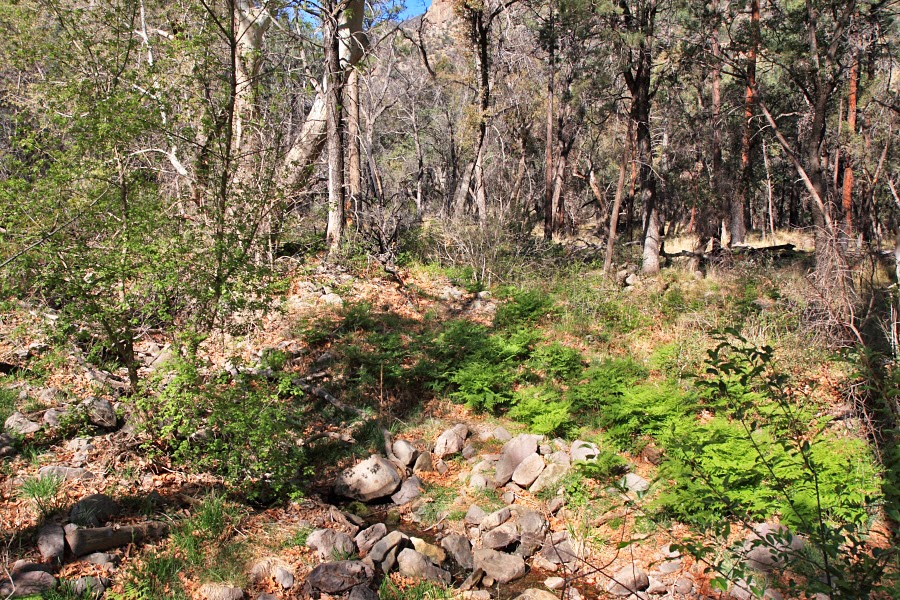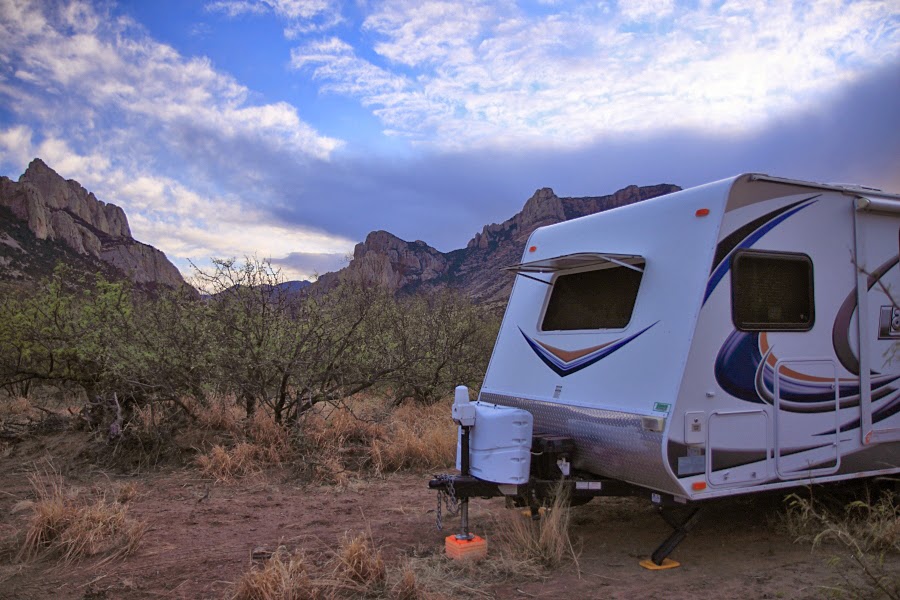There are many wonderful things that keep me returning to the Chiricahuas; one of them is that you can visit 6 basic plant communities, each supporting their own unique birds, within a span of at most 20 road miles. And if you get off the (mostly) dirt roads and hike, there are more hidden treasures to explore..Ash Springs and the surrounding area is one such place. The springs creates a habitat that you would find 3,000 feet above, in the high Chiricahuas. The trail begins at Herb Martyr (I still think that's a wonderful name, and it was the actual name of a worker on the small dam built there who died during the construction) campground and climbs where you can get good views of the surrounding landscape --
And then you enter into a canyon and an area called the Cima Creek Cienega, where the springs and creek create a micro-climate, an area of inviting coolness and ferns --
House Wrens are here. But not just your "typical" House Wren; they can be of the "Brown-throated" subspecies, what looks like a "mutated" House Wren with a unique call all its own --
Painted Redstarts, a bird that could be called a "signature" bird of the Chiricahuas, are present too --
This pocket of green is a unique place, full of singing birds and green ferns -- truly one of the "hidden treasures" of the Chiricahuas. But now it's time to go "up top", to the high Chiricahuas and one of the wondrous "gems" of the entire mountain range, Barfoot Park. The next day, after a pretty sunrise at my boondocking spot

I drive the Tundra up the trans-mountain road that eventually leads to the western side of the Chiricahuas and the "wonderland of rocks", Chiricahua National Monument. At Onion Saddle the roads descends to the other side, but I take the road to Rustler Park. The elevation here is around 9,000 feet and though this, tragically, is an area that was devastated by 2012's Horseshoe 2 fire, it's still magical, and the fire seems to have had less effect on the birds than was originally feared. And the fire spared Barfoot Park for the most part, though there are charred trees where it seemed as if the fire selectively burned a few, then completely missed others standing nearby --

This is Barfoot Park. It was declared a National Natural Landmark by the US Park Service in 2011, a year before the fire, and it's easy to see why. That's Buenva Vista Peak behind it, which I will climb later in the morning. There used to be a fire lookout on the peak that was easily visible from the park, but that burned down in the 2012 fire. Barfoot and the surrounding area is home to Zone-tailed Hawk along with a least two Short-tailed Hawks, a bird usually found in the United States only in Florida, but Noel and Helen Snyder, residents of Portal, scientists and raptor-watchers, discovered a Short-tailed nest here a few years back, and put up a blind to study the nesting behavior. Hepatic Tanagers come here starting around April 15, and during my previous visits I've seen Mexican Chickadee, Grace's Warbler and Cordilleran Flycatcher, among others, and have been serenaded at night by Mexican Whip-poor-will. So who knows what I might see during my stay at Barfoot Park? But first, it's a climb up to Buena Vista Peak. There's a trail that goes from the park to a saddle, then it's only 1/2 mile to Buena Vista (aptly named). Once the trail leaves there bowl of the Park, the extent of the 2012 fire can be seen everywhere --

The green path is the trail, and Buena Vista is up on the left. Up on the saddle there used to be a fairly thick forest, but now it's nearly all dead trees --
And finally, at the top of Buena Vista Peak, and the former site of Barfoot Lookout; this is looking west, with Barfoot Peak on the right --
As you can see, I brought my 500 f/4 lens with me because I'd like to get the best-quality photos of any animal or bird I might encounter; you just never know what you may come across, and it is my dayhiking lens of choice. Alas, I really didn't see any "good" birds during that hike, but I WOULD have if I hadn't brought The Big Boy with me... ;o). This is a great view for a panorama -- the only
way you can get a feel for the vast sweep of the land --
In this panorama, you can really see how the fire came from the left and burned the forest nearly all the way to the bowl of Barfoot Park, that light-colored clear field in the bottom center; it seems to have miraculously stopped right there. Here's a closer photo of Barfoot Park and Peak --

As it turns out, just when I was up here, taking photos of the superlative views, down at Barfoot Park a bird seen only in Mexico was being observed -- by two full-time RVers/birders who I had bumped into earlier that day. The bird was a Slate-throated Redstart, which looks somewhat similar to a Painted Redstart, except there is no white wing patch, or a white crescent under its eyes. One had been seen the year before at the Southwestern Research Station, but this one was WAY out of its usual habitat -- it should have been about 4,000 feet lower, which explains that only a very few observers saw it when it was a Barfoot Park -- and I was not one of them. After I had returned down to Barfoot Park and found out about the Slate-throated from other birders who had seen the report on the Web, I searched and played the call on my BirdJam iPod Nano, but I never saw it up to the time I left Barfoot the next morning. Alas...But I always have a good story to tell how I ALMOST saw it...However, there were Yellow-eyed Juncos at the Park; I've always found them friendly and inquisitive --

My camping area at Barfoot was perfect, with wood (I'd been stashing it in the back of the Tundra for nearly a year) for a fire --
There weren't any Whip-poor-wills around this time for a nighttime serenade, but the three-quarters moon was beautiful; this was taken handheld with my 500 f/4 lens --
It was just a grand and glorious time to be at Barfoot Park. Though I missed out on the Zone-tailed Hawk, Short-tailed Hawk -- and ok, thanks for reminding me, the Slate-throated Redstart -- I was in Barfoot Park, spending the night, and I could think of no-place I would rather be. And I knew I'd return in a week's time, spending 2 nights, and getting a 2nd chance on things I'd missed this time...







































































